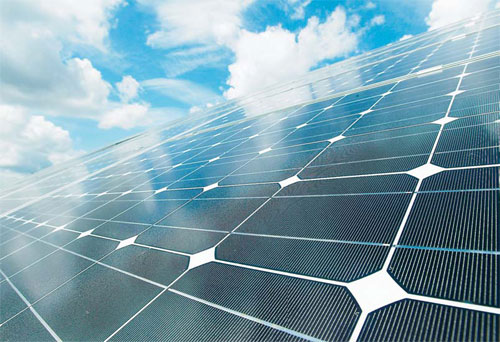
(Xinhua File Photo)
A comprehensive package of new polices from the central and local departments has brought rays of hope to the struggling Chinese photovoltaic (PV) solar industry.
The industry, considered a promising and emerging one in China with strategic importance for the transformation of the national economy, was suffering a grim situation in the past few months.
Since last year, the United States and the EU have both launched punitive tariffs stemming from anti-dumping and anti-subsidies investigations aiming at the Chinese PV solar companies.
It has hurt the survival and development of those firms, which have heavily relied on overseas markets.
The debt of China's top ten largest PV solar companies adds up to 111.0 billion yuan (about 17.5 billion U.S. dollars) and the liability ratio of the whole industry has been over 70 percent, according to the statistics released by MaximGroup, a U.S. investment management institution.
Actually, not individual, but multiple, reasons resulted in the severe status quo of the industry.
The industry developed so fast that its production capacity easily outweighed domestic demand. And excessive production capacity means this is a large-scale crisis for the whole industry, rather than just a problem of individual companies.
Furthermore, the export-oriented PV solar industry in China is vulnerable to the external economic environment. If the foreign market weakens, disaster for the whole industry is almost inevitable.
Trade protectionism moves by the western countries additionally made the situation worse.
Most Chinese photovoltaic enterprises have a limited understanding of marketing. In fact, they are duplicating the old Made-in-China practices in a new industry.
They attempted to compete with lower prices in the global market, not with more advanced technology and innovation. That's why they are easily deemed as targets by developed countries.
Meanwhile, the sharp price drop of PV products around the world also influenced Chinese PV solar industry.
In the past six years, prices of photovoltaic modules decreased 86.6 percent, system prices were down 83.3 percent and solar electricity prices dropped 76.2 percent, according to China Daily.
To overcome the difficulties, companies should increase their input in research and development and make innovation their most competitive strength. They must attain more experience of the changing international market as fast as possible to adjust their production and marketing strategies accordingly, experts suggested on the economic newspaper 21st Century Business Herald.
Moreover, the Chinese government should do more in the framework of the WTO to help Chinese companies defend their legal interests.
STRONG SUPPORTS FROM CENTRAL GOVERNMENT
China is planning to stimulate the development of the PV solar industry to get through tough times by expanding the domestic market.
Vigorously developing new and renewable energy is a key strategic measure for promoting the diversified and clean energy development and for fostering new strategic industries, said a white paper on China's energy policy released on Wednesday by the Information Office of the State Council.
On Friday, State Grid Corporation of China (SGCC), the country's largest state-owned utility company, announced a plan to allow small-scale distributed solar power generators to connect to its power lines.
Under the plan, SGCC will allow solar power generators with less than 6 megawatts of installed capacity to be connected to the grid.
SGCC will also provide technological assistance and waive charges associated with connecting to the grid, Wang Xiangqin, SGCC deputy chief economist, said.
The move will boost domestic demand and shore up the solar industry, analysts said.
Connecting distributed solar power to the national grid is a crucial step in removing obstacles that have contained the development of China's solar industry, said Shi Lishan, deputy director of the new and renewable energy department of the National Energy Administration (NEA).
The move is seen as very encouraging news by Meng Xiangan, deputy director of the China Renewable Energy Society.
"The obstacles that companies face in order to be connected to the national grid are the biggest problem for the PV solar power industry, as well as many other new energy industries," he noted. "The new plan will help solve the problem, and it shows the central government's determination to support the development of the solar industry by solving the grid-connection issue."
"Distributed solar power generation will allow the industry to develop, as long as the grid-connection problems can be solved," Meng added. "That's why State Grid's new policy is very important."
The struggling PV solar firms are even more glad to hear the news.
The new plan is an important move made by the central government to help the solar PV industry through its current hardship, said Tong Xingxue, president and chief operating officer of LDK Solar Co., a leading producer of solar wafers.
However, on the practical effects of the new measure, the SGCC spokesman Zhang Zhengling pointed out that it still counts on the supports of the government.
Last month, the National Energy Administration announced an initiative to develop distributed solar power plants in a large scale, which encourages local governments to propose new solar power projects.
The country vowed to increase its installed generation capacity for solar power to over 21 million kilowatts by 2015, according to a recently released white paper China's Energy Policy 2012.
Besides, Chinese government is working on a subsidy policy for distributed solar power plants.
It plans to offer subsidies ranging from about 0.4 yuan (about 0.06 U.S. dollars) to 0.6 yuan for each kilowatt-hour of distributed solar power. The amount includes subsidies from both the central and local governments.
"The new subsidy policy means that the more electricity the distributed solar power plants generate, the more subsidy the companies will get," said Meng. "It's a very helpful measure to further open the domestic market."

Copyright ©1999-2011 Chinanews.com. All rights reserved.
Reproduction in whole or in part without permission is prohibited.